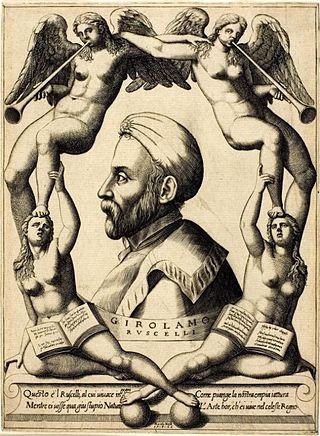
Padua is a city and commune in Veneto,northern Italy. Padua is on the river Bacchiglione,west of Venice. It is the capital of the province of Padua. It is also the economic and communications hub of the area. Padua's population is 214,000. The city is sometimes included,with Venice and Treviso,in the Padua-Treviso-Venice Metropolitan Area (PATREVE) which has a population of around 2,600,000.

Vincenzo Scamozzi was an Italian architect and a writer on architecture,active mainly in Vicenza and Republic of Venice area in the second half of the 16th century. He was perhaps the most important figure there between Andrea Palladio,whose unfinished projects he inherited at Palladio's death in 1580,and Baldassarre Longhena,Scamozzi's only pupil.

Jacopo Facciolati (1682–1769) was an Italian lexicographer and philologist.

Paolo Frisi was an Italian mathematician and astronomer.

Girolamo Ruscelli (1518–1566) was an Italian Mathematician and Cartographer active in Venice during the early 16th century. He was also an alchemist,writing pseudonymously as Alessio Piemontese.

Egidio Forcellini was an Italian philologist.

Antonio Possevino was a Jesuit protagonist of Counter Reformation as a papal diplomat and a Jesuit controversialist,encyclopedist and bibliographer. He was the first Jesuit to visit Muscovy,Sweden,Denmark,Livonia,Hungary,Pomerania,and Saxony in amply documented papal missions between 1578 and 1586 where he championed the enterprising policies of Pope Gregory XIII.

Gian Vincenzo Pinelli was an Italian humanist,born in Naples and known as a savant and a mentor of Galileo. His literary correspondence put him at the center of a European network of virtuosi. He was also a noted botanist,bibliophile and collector of scientific instruments.

Leon was the 14th Agiad dynasty King of Sparta,ruling from 590 BC to 560 BC.
Eurycratides was the thirteenth king of Sparta from the Agiad dynasty. He succeeded his father Anaxander around 615 BC and reigned during a devastating period of war with Tegea.

The Diocese of Nardò-Gallipoli is a Latin diocese of the Catholic Church in southern Italy. It is a suffragan of the Archdiocese of Lecce.
Anaxander or Anaxandros was the 12th Agiad King of Sparta.

The Diocese of Padua is a Latin diocese of the Catholic Church in Veneto,northern Italy. It was erected in the 3rd century. The diocese of Padua was originally a suffragan (subordinate) of the Patriarchate of Aquileia. When the Patriarchate was suppressed permanently in 1752,it became a suffragan of the Archdiocese of Udine. In 1818,when the dioceses of northern Italy were reorganized by Pope Pius VII,it became a suffragan of the Patriarchate of Venice,and remains so today.

The Diocese of Massa Carrara-Pontremoli is a Latin diocese of the Catholic Church situated in north-western Tuscany,in the valley of the Frigido River. The city of Massa is on the south side of the river,5 km from the Tyrrhenian Sea. The city of Carrara is 6 km north of Massa,on the Carrione River. The diocese is a suffragan of the Archdiocese of Pisa.

The migration waves of Byzantine Greek scholars and émigrés in the period following the end of the Byzantine Empire in 1453 is considered by many scholars key to the revival of Greek studies that led to the development of the Renaissance humanism and science. These émigrés brought to Western Europe the relatively well-preserved remnants and accumulated knowledge of their own (Greek) civilization,which had mostly not survived the Early Middle Ages in the West. The Encyclopædia Britannica claims:"Many modern scholars also agree that the exodus of Greeks to Italy as a result of this event marked the end of the Middle Ages and the beginning of the Renaissance",although few scholars date the start of the Italian Renaissance this late.

Francesco Panigarola was an Italian Franciscan preacher and controversialist,and Bishop of Asti.

Vincenzo Marinelli was an Italian painter,known best for his Orientalist canvases based on his travels in Greece,Crete,Egypt,and Sudan.
Clemente Sibiliato or Sibilato was an Italian cleric,poet,and librarian.
Aldo Ferrabino was an Italian historian,philosopher,librarian,writer,and poet. A graduate of the University of Turin,he taught ancient history at the University of Padua and the Sapienza University of Rome,later becoming rector at the University of Padua in 1947. From 1948 to 1954,he served in the Italian Senate for the Christian Democracy party. In 1950,he become a correspondent for the Accademia dei Lincei,and the president of the Istituto Centrale per il Catalogo Unico. From 1954 to 1972,he was president of the Treccani encyclopaedia. In 1956,he was elected the president of the Dante Alighieri Society. In 1957,he co-founded the magazine Il Veltro with Vincenzo Cappelletti. Considered an expert on Christology and the philosophy of history,he was made a Knight of the Civil Order of Savoy in 1970.















